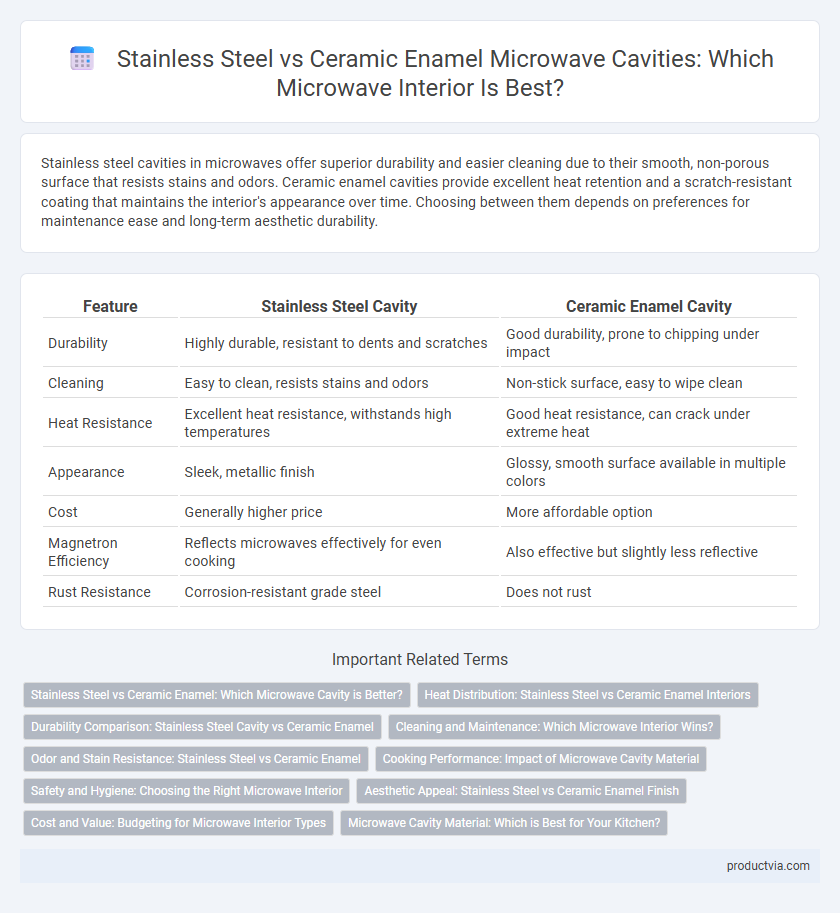Stainless steel cavities in microwaves offer superior durability and easier cleaning due to their smooth, non-porous surface that resists stains and odors. Ceramic enamel cavities provide excellent heat retention and a scratch-resistant coating that maintains the interior's appearance over time. Choosing between them depends on preferences for maintenance ease and long-term aesthetic durability.
Table of Comparison
| Feature | Stainless Steel Cavity | Ceramic Enamel Cavity |
|---|---|---|
| Durability | Highly durable, resistant to dents and scratches | Good durability, prone to chipping under impact |
| Cleaning | Easy to clean, resists stains and odors | Non-stick surface, easy to wipe clean |
| Heat Resistance | Excellent heat resistance, withstands high temperatures | Good heat resistance, can crack under extreme heat |
| Appearance | Sleek, metallic finish | Glossy, smooth surface available in multiple colors |
| Cost | Generally higher price | More affordable option |
| Magnetron Efficiency | Reflects microwaves effectively for even cooking | Also effective but slightly less reflective |
| Rust Resistance | Corrosion-resistant grade steel | Does not rust |
Stainless Steel vs Ceramic Enamel: Which Microwave Cavity is Better?
Stainless steel cavities in microwaves offer superior durability, resistance to scratches, and better heat distribution compared to ceramic enamel interiors, which can chip or stain over time. Stainless steel's non-porous surface resists odors and bacteria buildup, ensuring easier cleaning and longer-lasting hygiene. While ceramic enamel provides a smooth, visually appealing finish, stainless steel is generally preferred for its enhanced performance and maintenance benefits in microwave ovens.
Heat Distribution: Stainless Steel vs Ceramic Enamel Interiors
Stainless steel cavities in microwaves offer superior heat distribution thanks to their reflective surface, ensuring even cooking by bouncing microwaves uniformly throughout the interior. Ceramic enamel cavities absorb some microwave energy, leading to slightly less uniform heat distribution but providing a scratch-resistant and easy-to-clean surface. Choosing between the two depends on the priority of even heating performance versus surface durability and maintenance.
Durability Comparison: Stainless Steel Cavity vs Ceramic Enamel
Stainless steel cavities in microwaves offer superior durability due to their resistance to corrosion, scratches, and stains, ensuring a longer lifespan under frequent use. Ceramic enamel cavities, while visually appealing and easier to clean, tend to be more susceptible to chipping and discoloration over time. The robust nature of stainless steel makes it a preferred choice for users prioritizing longevity and heavy-duty performance in microwave interiors.
Cleaning and Maintenance: Which Microwave Interior Wins?
Stainless steel cavity microwaves offer superior durability and scratch resistance, making them easier to wipe clean without worrying about surface damage. Ceramic enamel cavities feature a smooth, non-porous surface that resists stains and odors and can be cleaned effectively with mild detergents and non-abrasive sponges. For maintenance, stainless steel requires regular polishing to prevent fingerprints, while ceramic enamel's resistance to discoloration ensures it retains a cleaner appearance with minimal effort.
Odor and Stain Resistance: Stainless Steel vs Ceramic Enamel
Stainless steel cavity in microwaves offers superior odor resistance due to its non-porous surface that prevents food odors from lingering and is highly resistant to staining from spilled sauces or strong spices. Ceramic enamel cavities provide decent stain resistance but can absorb odors over time, especially if not cleaned promptly, leading to persistent smells inside the microwave. For maintaining a fresh-smelling interior and long-lasting stain resistance, stainless steel cavities are generally the preferred choice.
Cooking Performance: Impact of Microwave Cavity Material
Stainless steel cavities in microwaves offer superior heat reflection, resulting in more even cooking and faster heating times compared to ceramic enamel cavities, which tend to absorb some microwave energy. The reflective properties of stainless steel enhance microwave distribution, reducing hot and cold spots inside the oven. Ceramic enamel cavities, while easier to clean, may lead to less consistent cooking performance due to their lower microwave reflectivity.
Safety and Hygiene: Choosing the Right Microwave Interior
Stainless steel cavities in microwaves offer superior durability and resist corrosion, making them highly hygienic and easy to clean, which reduces bacterial buildup and enhances safety. Ceramic enamel interiors provide a smooth, non-porous surface that prevents food residue from sticking, ensuring effective cleanliness and minimizing the risk of contamination. Selecting the right microwave interior depends on prioritizing both the ease of maintenance and the long-term preservation of a safe cooking environment.
Aesthetic Appeal: Stainless Steel vs Ceramic Enamel Finish
Stainless steel cavities in microwaves offer a sleek, modern aesthetic with a reflective surface that resists staining and maintains its shine over time, enhancing durability and ease of cleaning. Ceramic enamel cavities provide a smooth, matte finish available in various colors, delivering a softer, more elegant look that blends seamlessly with diverse kitchen decor. Both finishes contribute differently to kitchen aesthetics, with stainless steel emphasizing a contemporary industrial appeal and ceramic enamel offering versatile design options.
Cost and Value: Budgeting for Microwave Interior Types
Stainless steel microwave cavities generally have a higher upfront cost but offer superior durability and long-term value due to scratch resistance and ease of cleaning. Ceramic enamel cavities are more budget-friendly, providing efficient heat retention and a smooth surface, but they may stain or chip over time, leading to potential replacement costs. When budgeting, consider the balance between initial investment and maintenance expenses to determine the most cost-effective microwave interior for your needs.
Microwave Cavity Material: Which is Best for Your Kitchen?
Stainless steel cavity microwaves offer superior durability and easier cleaning due to their smooth, non-porous surface, enhancing heat reflection for even cooking. Ceramic enamel cavities, while highly resistant to scratches and stains, provide a non-metallic interior that reduces bacterial growth and offers enhanced aesthetic appeal. Choosing between these materials depends on priorities such as maintenance ease, longevity, and cooking performance.
Stainless Steel Cavity vs Ceramic Enamel Cavity for Microwave Interiors Infographic

 productvia.com
productvia.com